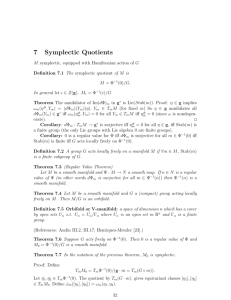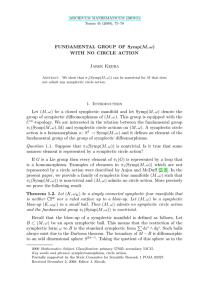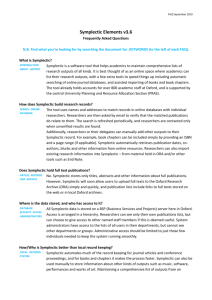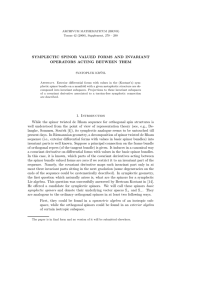Geometry of Singular Symplectic Quotients
advertisement
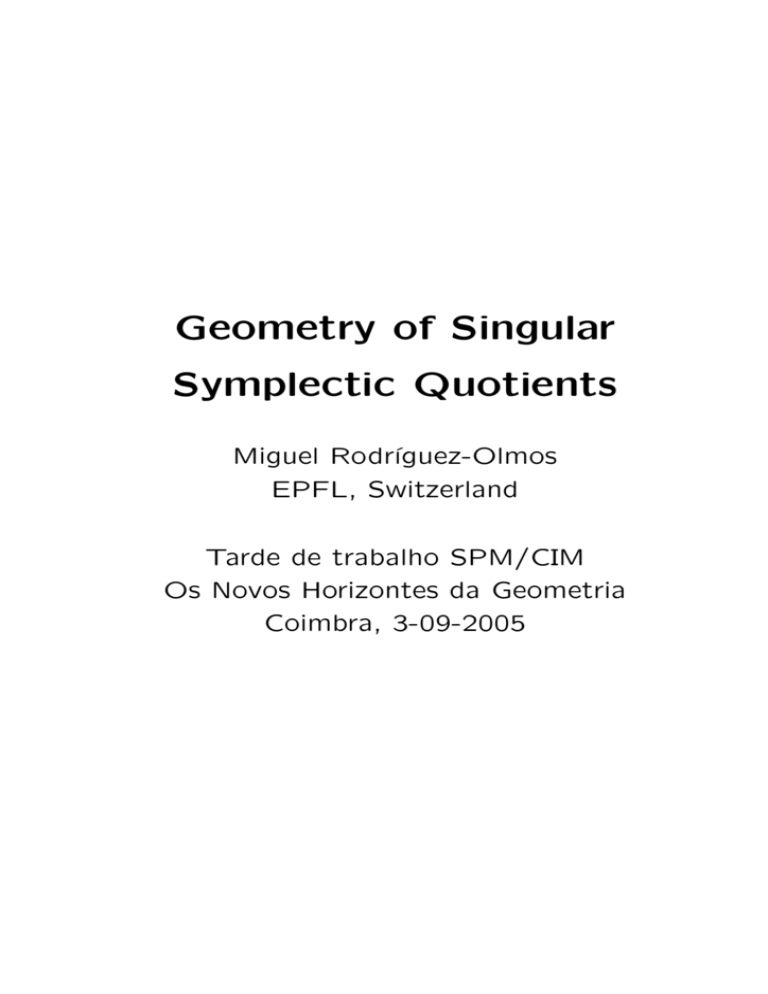
Geometry of Singular
Symplectic Quotients
Miguel Rodrı́guez-Olmos
EPFL, Switzerland
Tarde de trabalho SPM/CIM
Os Novos Horizontes da Geometria
Coimbra, 3-09-2005
Introduction: Symplectic Reduction
Let (P, ω, G, J) be a Hamiltonian space, where
• (M, ω) is a symplectic manifold,
• G × P → P is a smooth and proper Hamiltonian action, and
• J : P → g∗ equivariant momentum map
ω(ξP , ·) = dhJ, ξi,
ξ ∈ g.
Symplectic Reduction: If µ ∈ g∗ is a regular
value of J and Gµ acts freely on J−1(µ) then
the quotient space
Pµ = J−1(µ)/Gµ
is a smooth symplectic manifold.
and Weinstein, 1974)
(Marsden
1
The reduced symplectic form ωµ on Pµ is defined by
i∗µω = πµ∗ ωµ
where
• iµ : J−1(µ) ,→ P is the inclusion, and
• πµ : J−1(µ) → Pµ : J−1(µ)/Gµ is the projection.
If µ is not regular or Gµ does not act freely
on J−1(µ) then Pµ is a symplectic stratified
space (it is partitioned in smooth symplectic
manifolds with reduced symplectic forms like
in the regular case).
Goal: Explain this symplectic stratification of
Pµ when µ is not regular (singular µ).
2
Reduction in Mechanics and Geometry
• Symmetric Hamiltonian dynamics: The components of J are conserved quantities (Theorem of Nöether), Pµ is the space of symmetric equivalence classes of dynamical states
with fixed momentum µ.
The original dynamics on P can be dropped
to Pµ reducing the dimensionality of the
problem. (for example N-body problem,
P = T ∗(R3N ), G = SO(3), J=angular momentum).
• Coadjoint orbits: P = T ∗G = G × g∗ with
action g · (g 0, ν) = (gg 0, ν) and momentum
J(g, ν) = Ad∗g−1 ν. Then Pµ = Oµ (coadjoint orbit through µ and ωµ is the (−)
Konstant-Kirillov-Souriau form, i.e.
ωµ(λ)(adξ λ, adη λ) = −hλ, [ξ, η]i,
for λ ∈ Oµ, adξ λ, adη λ ∈ TλOµ, with ξ, η ∈ g.
3
• Moduli space of flat connections: K compact and ζ : K → M → Σ a principal bundle over a closed oriented surface Σ. The
space A of connections of ζ has a symplectic form
Z
ω(A)(α, β) =
Σ
κ(α ∧ β),
Gζ acts on A by g · A = g −1Ag + g −1dg.
with momentum map J(A) = FA. Then
P0 = {A ∈ A : FA = 0}/Gζ
has a reduced symplectic structure (ChernSimons theory, low-dimensional topology).
• Toric manifolds: Tn × Cn → Cn as
(θ1, . . . , θn)·(z1, . . . , zn) = (e2πiθn z1, . . . , e2πiθ1 zn).
Tk ,→ Tn subtorus acting on Cn by restriction with momentum map J : Cn → Rk corresponding to ω = 2i Σk dzk ∧ dzk .
M = J−1(0)/G is a toric manifold for Tn−k
(Delzant construction).
4
Bifurcation Lemma
Singular reduction starts with the Bifurcation
Lemma (Arms, Marsden, Gotay 1981):
range (Tz J) = (gz )◦.
In other words: µ is a singular value of J iff
J−1(µ) contains a point with continuous stabilizer.
The study of singularities of the momentum
map is equivalent to the study of singularities
of the Hamiltonian group action on P.
5
Slice Theorem
Associated Bundle: Let H ⊂ G compact act
on a vector space A. H acts on G × A by
h · (g, a) = (gh−1, h · a)
We denote the quotient space as
G ×H A := (G × A)/H.
• G×H A is an associated bundle to G → G/H
over G/H with fiber A.
• G acts on G ×H A by g 0 · [g, a] = [g 0g, a].
• Slice Theorem: G × M → M proper action. x ∈ M , S = TxM/g · x. Then
φ : G ×Gx S → M
is an equivariant tubular neighborhood of
G · x (Palais 1961).
6
Symplectic Slice Theorem
(P, ω, G, J) Hamiltonian G-space, J(z) = µ.
• N = ker Tz J/gµ·z (symplectic normal space).
(N, ω|N , H, JN ) Hamiltonian linear H-space,
hJN (v), ξi =
1
ωN (ξ · v, v).
2
• φ : Y := G ×Gz ((gµ/gz )∗ ⊕ N ) → P.
φ is a G-equivariant symplectomorphism with
respect to a natural symplectic form ωY .
• (Marle 1985, Guillemin and Sternberg 1984)
(Y, ωY , G, JY ) is a Hamiltonian G-space with
JY ([g, ν, v]) = Ad∗g−1 (µ + ν + JN (v)).
• Lerman-Bates Lemma (1997): There exists a neighborhood Y0 ⊂ Y such that
J−1
Y (µ) ∩ Y0
=
³
´
−1
Gµ ×Gz (0 × JN (0)) ∩ Y0.
7
Stratified Spaces
X topologicalaspace. A locally finite disjoint
parition X =
Xi is a stratification of X if
i
• smoothness: Xi are smooth manifolds,
• frontier condition:
Xi ∩ Xj 6= ∅ ⇒ Xi ⊆ ∂Xj (∂Xj = Xj \Xj ).
Application: G × M → M proper action. Then
M/G =
a
M(H)/G,
where
(H)
- (H) is the conjugacy class of H in G, and
- M(H) = {x ∈ M : Gx ∈ (H)} (orbit type).
Why?−→ use slices: near G · x with Gx = H,
M ' G ×H S ' G/H × S. Then
M(H) ' (G ×H S)(H) = G ×H SH ' G/H × SH
8
⇒ M(H) is a G-submanifold of M .
1. smoothness: Near [x] ∈ M(H)/G,
M(H)/G ' (G ×H SH )/G = SH /H = SH ' Rk .
⇒ M(H)/G is a smooth manifold.
2. frontier conditions: Analogously,
M(H)/G ⊆ ∂(M(K)/G) ⇔ (K) < (H).
(isotropy stratification of M/G)
Strategy to study the symplectic stratification:
repeat this for a Hamiltonian G-space using the
Symplectic Slice Theorem instead.
9
Symplectic Stratification of P0
(P, ω, G, J) Hamiltonian G-space. Suppose 0 is
a singular value of J : P → g∗. Then J−1(0)
and P0 = J−1(0)/G are singular spaces.
Theorem: (Sjamaar, Lerman 1991).
(i) The sets J−1(0)∩P(H) and (J−1(0)∩P(H))/G
are smooth manifolds, and
P0 =
a ³
J−1(0) ∩ P(H)
´
/G
(H)
is a stratification of P0.
(H)
(ii) Each stratum P0 := (J−1(0)∩P(H))/G is
symplectic with a reduced symplectic form
(H)
ω0
defined by
(H)
i0 ω
(H)
=
(H) ∗ (H)
π0
ω0 ,
where
- i0
: J−1(0) ∩ P(H) ,→ P and
- π0
: J−1(0) ∩ P(H) → P0
(H)
(H)
.
10
- Sketch of proof of (i): z ∈ P with Gz = H.
Using Lerman-Bates Lemma, near G · z
−1
(0)
=
G
×
(0
×
J
J−1(0) ' J−1
H
Y
N (0)).
0
1
• N H ⊆ J−1
N (0) (hJN (v), ξi = 2 ωN (ξ · v, v))
• Then J−1(0) ∩ P(H) is a manifold:
J−1
Y0 (0) ∩ (Y0)(H) =
=
'
⊆
(H)
(i) smoothness: P0
H)
(0))
G ×H (0 × (J−1
N
H
G ×H (0 × N )
G/H × (0 × N H )
G/H × ((g/gz )∗ ⊕ N ) ' Y0
is a manifold.
H
H
k
(J−1
Y (0) ∩ (Y0)(H) )/G = N /H = N ' R
0
(ii) frontier conditions: follow from frontier
(H)
conditions for P/G since P0 ⊆ P(H)/G.
(H)
P0
(K)
⊆ ∂P0
⇔ (K) < (H).
11
- Sketch of proof of (ii): Sjamaar Principle:
PH is a symplectic submanifold of P. N (H)/H
acts FREELY and Hamiltonially on (PH , ω|PH )
with momentum map JPH . Then there is a
diffeomorphism
(H)
f : P0
→ J−1
P (0)/(N (H)/H).
H
(Sjamaar, Lerman 1991).
Then J−1
PH (0)/(N (H)/H) is a Marsden-Weinstein
reduced manifold with reduced symplectic form
Ω. Then pull-back
(H)
ω0
:= f ∗Ω
satisfies the requirements of the Sjamaar-Lerman
Theorem:
(H)
i0 ω
=
(H) ∗ (H)
π0
ω0 .
12
Cotangent Lifted Actions
• Q smooth manifold, (τ : T ∗Q → Q, ωQ) is
canonically a symplectic manifold:
for px ∈ Tx∗Q, V ∈ Tpx (T ∗Q),
ΘQ(px)(V ) = hpx, Tpx τ (V )i,
ωQ = −dΘQ.
• G × Q → Q base action ⇒ G × T ∗Q → T ∗Q
lifted action. A lifted action is always
Hamiltonian.
• If G × Q → Q is free, proper, then
G × T ∗Q → T ∗Q is also free, proper.
• Momentum map hJ(px), ξi = hpx, ξQ(x)i.
13
Regular Cotangent Bundle Reduction
G × Q → Q free and proper action. Then
every momentum value is regular. How are the
Marsden-Weinstein reduced spaces?→ They are
bundles:
• (µ = 0): There is a symplectomorphism
(J−1(0)/G, ω0) → (T ∗(Q/G), ωQ/G) (Satzer
1977).
• (µ 6= 0): There is a symplectic embedding
(J−1(µ)/G, ωµ) → (T ∗(Q/Gµ), ωQ/Gµ −τ ∗Bµ)
onto a subbundle of T ∗(Q/Gµ).
Bµ is a closed differential 2-form on Q/Gµ
obtained from a principal connection on
Gµ → Q → Q/Gµ.
(Abraham, Marsden 1978).
14
Singular Cotangent Bundle Reduction
Motivation: G × Q → Q not free ⇒ 0 ∈ g∗
singular momentum value: The smooth cotangent bundle projection τ : T ∗Q → Q induces a
continuous projection τ0 : P0 → Q/G.
• In the regular case, P0 = T ∗(Q/G) and τ0 is
a smooth fibration (the cotangent bundle
projection τ0 : T ∗(Q/G) → Q/G).
• Everything is constructible from G×Q → Q.
• In the singular case we expect τ0 to be a
stratified fibration (maps strata to strata
and restricts to smooth fibrations). This
(H)
FAILS! since τ0(P0 ) = Q(H)/G 6= Q(H)/G.
Solution: Substitute the symplectic stratification of P0 with the finer coisotropic stratification.
15
Seams
Consider one orbit type submanifold Q(H) ⊂
Q. (T ∗Q(H), ωQ(H) , G, J(H)) is a Hamiltonian Gspace obtained by restriction from (T ∗Q, ωQ, G, J).
∗
N ∗Q(H) ⊂ TQ
(H)
Q conormal bundle to Q(H),
inherits a G-action. Facts:
• (N ∗Q(H))(K) 6= ∅ ⇔
Q(K) 6= ∅
and
(K) ≤ (H).
J−1
(0)×(N ∗ Q(H) )(K)
(H)
• SH→K :=
→ Q(H)/G is
G
a smooth bundle.
• SH→H = T ∗(Q(H)/G) (Emmrich-Romer 1991).
We call SH→K with (K) < (H) a seam.
16
Decomposition of the Symplectic Strata
In the cotangent bundle case we can write
the following decomposition of every symplectic stratum:
(K)
P0
=
a
T ∗(Q(K)/G)
SH→K
(K)<(H)
Furthermore:
(K)
• P0
6= ∅ ⇔ Q(K) 6= ∅.
(K)
• T ∗(Q(K)/G) is open and dense in P0
.
(K)
• The reduced symplectic form ω0
is the
unique extension of ωQ /G from T ∗(Q(K)/G)
(K)
(K)
to P0
.
(K)
• Seams SH→K are coisotropic in (P0
(K)
, ω0
17
).
The Coisotropic Stratification of P0
Let IQ = {(H) : Q(H) 6= ∅}. Take every
cotangent bundle and seam of the form
• T ∗(Q(L)/G),
(L) ∈ IQ,
(K), (K 0) ∈ IQ, (K) < (K 0).
• SK 0→K ,
then
P0 =
a
(L)
T ∗(Q(L)/G)
a
(K)<(K 0)
SK→K 0
with (L), (K), (K 0) ∈ IQ is a stratification of P0
(Perlmutter, Sousa-Dias, R-O 2003).
Notice: The strata are bundles over strata of
Q/G, indeed
T ∗(Q(L)/G) −→ Q(L)/G
SK→K 0 −→ Q(K)/G.
18
Properties of the Coisotropic
Stratification
- The continuous projection τ0 : P0 → Q/G IS
a stratified fibration with respect to the secondary stratification of P0 and the isotropy
stratification of Q/G.
- The frontier conditions: (gluing cotangent
bundles):
T ∗(Q(K)/G) ⊂ ∂ T ∗(Q(H)/G) ⇔ (H) < (K)
T ∗(Q(K)/G) ⊂ ∂ SK→H
⇔ (H) < (K)
SK→H ⊂ ∂ T ∗(Q(H)/G)
⇔ (H) < (K)
SK 0→H ⊂ ∂ SK→H
⇔ (H) < (K) < (K 0)
SK→H 0 ⊂ ∂ SK→H
⇔ (H) < (H 0) < (K)
- The strata are coisotropic submaifolds of their
respective symplectic strata.
19

